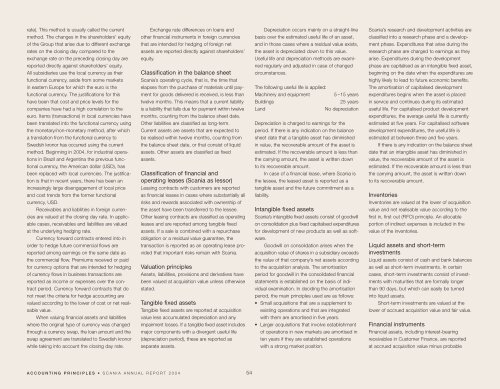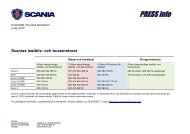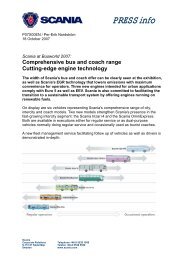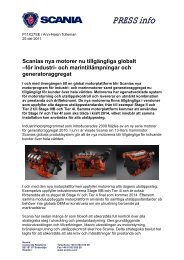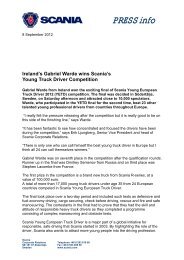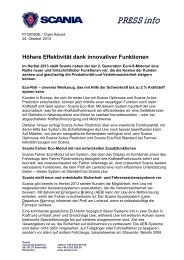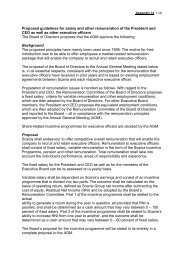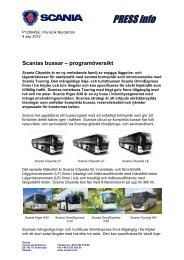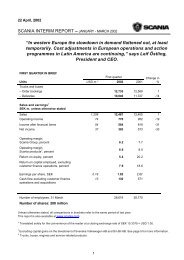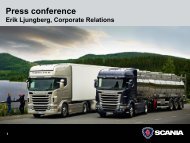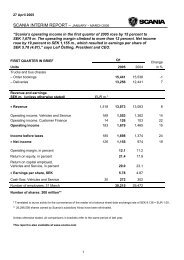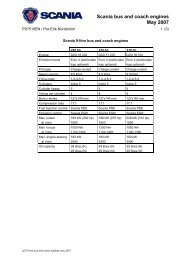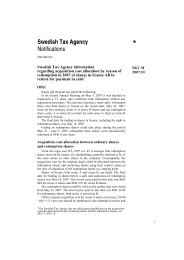Scania annual report 2004
Scania annual report 2004
Scania annual report 2004
You also want an ePaper? Increase the reach of your titles
YUMPU automatically turns print PDFs into web optimized ePapers that Google loves.
ate). This method is usually called the current<br />
Exchange rate differences on loans and<br />
Depreciation occurs mainly on a straight-line<br />
<strong>Scania</strong>’s research and development activities are<br />
method. The changes in the shareholders’ equity<br />
other financial instruments in foreign currencies<br />
basis over the estimated useful life of an asset,<br />
classified into a research phase and a develop-<br />
of the Group that arise due to different exchange<br />
that are intended for hedging of foreign net<br />
and in those cases where a residual value exists,<br />
ment phase. Expenditures that arise during the<br />
rates on the closing day compared to the<br />
assets are <strong>report</strong>ed directly against shareholders’<br />
the asset is depreciated down to this value.<br />
research phase are charged to earnings as they<br />
exchange rate on the preceding closing day are<br />
equity.<br />
Useful life and depreciation methods are exami-<br />
arise. Expenditures during the development<br />
<strong>report</strong>ed directly against shareholders’ equity.<br />
All subsidiaries use the local currency as their<br />
functional currency, aside from some markets<br />
Classification in the balance sheet<br />
<strong>Scania</strong>’s operating cycle, that is, the time that<br />
ned regularly and adjusted in case of changed<br />
circumstances.<br />
phase are capitalised as an intangible fixed asset,<br />
beginning on the date when the expenditures are<br />
highly likely to lead to future economic benefits.<br />
in eastern Europe for which the euro is the<br />
elapses from the purchase of materials until pay-<br />
The following useful life is applied:<br />
The amortisation of capitalised development<br />
functional currency. The justifications for this<br />
ment for goods delivered is received, is less than<br />
Machinery and equipment<br />
5 –15 years<br />
expenditures begins when the asset is placed<br />
have been that cost and price levels for the<br />
twelve months. This means that a current liability<br />
Buildings<br />
25 years<br />
in service and continues during its estimated<br />
companies have had a high correlation to the<br />
is a liability that falls due for payment within twelve<br />
Land<br />
No depreciation<br />
useful life. For capitalised product development<br />
euro. Items (transactions) in local currencies have<br />
months, counting from the balance sheet date.<br />
expenditures, the average useful life is currently<br />
been translated into the functional currency using<br />
Other liabilities are classified as long-term.<br />
Depreciation is charged to earnings for the<br />
estimated at five years. For capitalised software<br />
the monetary/non-monetary method, after which<br />
Current assets are assets that are expected to<br />
period. If there is any indication on the balance<br />
development expenditures, the useful life is<br />
a translation from the functional currency to<br />
be realised within twelve months, counting from<br />
sheet date that a tangible asset has diminished<br />
estimated at between three and five years.<br />
Swedish kronor has occurred using the current<br />
the balance sheet date, or that consist of liquid<br />
in value, the recoverable amount of the asset is<br />
If there is any indication on the balance sheet<br />
method. Beginning in <strong>2004</strong>, for industrial opera-<br />
assets. Other assets are classified as fixed<br />
estimated. If the recoverable amount is less than<br />
date that an intangible asset has diminished in<br />
tions in Brazil and Argentina the previous func-<br />
assets.<br />
the carrying amount, the asset is written down<br />
value, the recoverable amount of the asset is<br />
tional currency, the American dollar (USD), has<br />
been replaced with local currencies. The justification<br />
is that in recent years, there has been an<br />
increasingly large disengagement of local price<br />
and cost trends from the former functional<br />
currency, USD.<br />
Receivables and liabilities in foreign currencies<br />
are valued at the closing day rate. In applic-<br />
Classification of financial and<br />
operating leases (<strong>Scania</strong> as lessor)<br />
Leasing contracts with customers are <strong>report</strong>ed<br />
as financial leases in cases where substantially all<br />
risks and rewards associated with ownership of<br />
the asset have been transferred to the lessee.<br />
Other leasing contracts are classified as operating<br />
to its recoverable amount.<br />
In case of a financial lease, where <strong>Scania</strong> is<br />
the lessee, the leased asset is <strong>report</strong>ed as a<br />
tangible asset and the future commitment as a<br />
liability.<br />
Intangible fixed assets<br />
<strong>Scania</strong>’s intangible fixed assets consist of goodwill<br />
estimated. If the recoverable amount is less than<br />
the carrying amount, the asset is written down<br />
to its recoverable amount.<br />
Inventories<br />
Inventories are valued at the lower of acquisition<br />
value and net realisable value according to the<br />
first in, first out (FIFO) principle. An allocable<br />
able cases, receivables and liabilities are valued<br />
leases and are <strong>report</strong>ed among tangible fixed<br />
on consolidation plus fixed capitalised expenditures<br />
portion of indirect expenses is included in the<br />
at the underlying hedging rate.<br />
assets. If a sale is combined with a repurchase<br />
for development of new products as well as soft-<br />
value of the inventories.<br />
Currency forward contracts entered into in<br />
order to hedge future commercial flows are<br />
<strong>report</strong>ed among earnings on the same date as<br />
the commercial flow. Premiums received or paid<br />
for currency options that are intended for hedging<br />
of currency flows in business transactions are<br />
obligation or a residual value guarantee, the<br />
transaction is <strong>report</strong>ed as an operating lease provided<br />
that important risks remain with <strong>Scania</strong>.<br />
Valuation principles<br />
Assets, liabilities, provisions and derivatives have<br />
ware.<br />
Goodwill on consolidation arises when the<br />
acquisition value of shares in a subsidiary exceeds<br />
the value of that company’s net assets according<br />
to the acquisition analysis. The amortisation<br />
period for goodwill in the consolidated financial<br />
Liquid assets and short-term<br />
investments<br />
Liquid assets consist of cash and bank balances<br />
as well as short-term investments. In certain<br />
cases, short-term investments consist of invest-<br />
<strong>report</strong>ed as income or expenses over the con-<br />
been valued at acquisition value unless otherwise<br />
statements is established on the basis of indi-<br />
ments with maturities that are formally longer<br />
tract period. Currency forward contracts that do<br />
stated.<br />
vidual examination. In deciding the amortisation<br />
than 90 days, but which can easily be turned<br />
not meet the criteria for hedge accounting are<br />
valued according to the lower of cost or net realisable<br />
value.<br />
Tangible fixed assets<br />
Tangible fixed assets are <strong>report</strong>ed at acquisition<br />
period, the main principles used are as follows:<br />
• Small acquisitions that are a supplement to<br />
existing operations and that are integrated<br />
into liquid assets.<br />
Short-term investments are valued at the<br />
lower of accrued acquisition value and fair value.<br />
When valuing financial assets and liabilities<br />
where the original type of currency was changed<br />
through a currency swap, the loan amount and the<br />
value less accumulated depreciation and any<br />
impairment losses. If a tangible fixed asset includes<br />
major components with a divergent useful life<br />
with them are amortised in five years.<br />
• Larger acquisitions that involve establishment<br />
of operations in new markets are amortised in<br />
Financial instruments<br />
Financial assets, including interest-bearing<br />
swap agreement are translated to Swedish kronor<br />
(depreciation period), these are <strong>report</strong>ed as<br />
ten years if they are established operations<br />
receivables in Customer Finance, are <strong>report</strong>ed<br />
while taking into account the closing day rate.<br />
separate assets.<br />
with a strong market position.<br />
at accrued acquisition value minus probable<br />
ACCOUNTING PRINCIPLES • SCANIA ANNUAL REPORT <strong>2004</strong> 54


